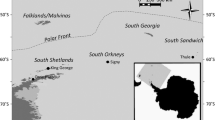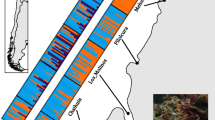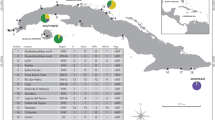Abstract
The endangered crocodile newt, Echinotriton andersoni, is a relatively large species of the family Salamandridae and is distributed on six islands in the central part of the Ryukyu Archipelago, Japan. Because of an originally small distribution range and recent habitat loss, this species has been steadily declining in number. To elucidate fine-scale population structure, which is essential for effective conservation management, we analyzed genetic diversity and gene flow based on nine microsatellite loci. Our results identified three different island groups (Amamioshima, Tokunoshima, and Okinawajima) and multiple genetic assemblages within the Amami and Okinawa island groups. The gross genetic variation within each island was positively correlated with island size. Population structure followed a latitudinal cline and isolation by distance, even among geographically isolated islands. In northern Okinawajima, relatively complex genetic structure was observed. This unexpected population structure seems to reflect historical migration and distribution expansion through the formation of land bridges and shifted coastlines in the Pleistocene. We also found that small islands showed little genetic variation (Ukeshima, Sesokojima, and Tokashikijima). In particular, our findings revealed that the Tokashikijima population is at greater risk for extinction than the other populations because it has the smallest effective population size.




Similar content being viewed by others
References
Bowcock AM, Ruiz-Linares A, Tomfohrde J et al (1994) High resolution of evolutionary trees with polymorphic microsatellites. Nature 368:455–457. https://doi.org/10.1038/368455a0
Campana MG, Hunt HV, Jones H, White J (2011) CorrSieve: software for summarizing and evaluating structure output. Mol Ecol Resour 11:349–352. https://doi.org/10.1111/j.1755-0998.2010.02917.x
Cornuet JM, Luikart G (1996) Description and power analysis of two tests for detecting recent population bottlenecks from allele frequency data. Genetics 144:2001–2014
Eldridge MDB, King JM, Loupis AK et al (1999) Unprecedented low levels of genetic variation and inbreeding depression in an island population of the black-footed rock-wallaby. Conserv Biol 13:531–541. https://doi.org/10.1046/j.1523-1739.1999.98115.x
Evanno G, Regnaut S, Goudet J (2005) Detecting the number of clusters of individuals using the software STRUCTURE: a simulation study. Mol Ecol 14:2611–2620. https://doi.org/10.1111/j.1365-294X.2005.02553.x
Felsenstein J (1989) PHYLIP—phylogeny inference package (Version 3.2). Cladistics 5:164–166
Frankham R (1996) Relationship of genetic variation to population size in wildlife. Conserv Biol 10:1500–1508. https://doi.org/10.1046/j.1523-1739.1996.10061500.x
Frankham R (1997) Do island populations have less genetic variation than mainland populations? Heredity (Edinb) 78(Pt 3):311–327. https://doi.org/10.1038/sj.hdy.6880980
Frankham R, Ballou JD, Briscoe DA (2002) Introduction to conservation genetics. Cambridge University Press, Cambridge
Garza JC, Williamson EG (2001) Detection of reduction in population size using data from microsatellite loci. Mol Ecol 10:305–318
Gilpin M, Soulé M (1986) Minimum viable populations: processes of species extinction. In: Soulé M (ed) Conservation biology: the science of scarcity and diversity. Sinauer Associates, Sunderland, pp 19–34
Giordano AR, Ridenhour BJ, Storfer A (2007) The influence of altitude and topography on genetic structure in the long-toed salamander (Ambystoma macrodactulym). Mol Ecol 16:1625–1637. https://doi.org/10.1111/j.1365-294X.2006.03223.x
Goudet J (2001) FSTAT, a program to estimate and test gene diversities and fixation indices (version 2.9.3). http://www2.unil.ch/popgen/softwares/fstat.htm
Guillot G, Estoup A, Mortier F, Cosson JF (2005) A spatial statistical model for landscape genetics. Genetics 170:1261–1280. https://doi.org/10.1534/genetics.104.033803
Guo SW, Thompson EA (1992) Performing the exact test of Hardy-Weinberg proportion for multiple alleles. Biometrics 48:361–372
Hayashi T, Matsui M, Utsunomiya T et al (1992) Allozyme variation in the newt Tylototriton andersoni from three islands of the Ryukyu archipelago. Herpetologica 48:178–184
Hikida T, Ota H (1997) Biogeography of reptiles in the subtropical East Asian Islands. In: Lue KY, Chen TH (eds) Proceedings of the symposium on the phylogeny, biogeography and conservation of fauna and flora of East Asian Region. National Science Council, R. O. C., Taipei, pp 11–28
Hinten G, Harriss F, Rossetto M, Braverstock PR (2003) Genetic variation and island biogreography: microsatellite and mitochondrial DNA variation in island populations of the Australian bush rat, Rattus fuscipes greyii. Conserv Genet 4:759–778. https://doi.org/10.1023/B:COGE.0000006113.58749.ac
Honda M, Matsui M, Tominaga A et al (2012) Phylogeny and biogeography of the Anderson’s crocodile newt, Echinotriton andersoni (Amphibia: Caudata), as revealed by mitochondrial DNA sequences. Mol Phylogenet Evol 65:642–653. https://doi.org/10.1016/j.ympev.2012.07.019
Hou M, Wu Y, Yang K et al (2014) A missing geographic link in the distribution of the genus Echinotriton (Caudata: Salamandridae) with description of a new species from southern China. Zootaxa 3895:89. https://doi.org/10.11646/zootaxa.3895.1.5
Hubisz MJ, Falush D, Stephens M, Pritchard JK (2009) Inferring weak population structure with the assistance of sample group information. Mol Ecol Resour 9:1322–1332. https://doi.org/10.1111/j.1755-0998.2009.02591.x
Igawa T, Okuda M, Oumi S et al (2011) Isolation and characterization of twelve microsatellite loci of endangered Ishikawa’s frog (Odorrana ishikawae). Conserv Genet Resour 3:421–424. https://doi.org/10.1007/s12686-010-9370-7
Igawa T, Oumi S, Katsuren S, Sumida M (2013a) Population structure and landscape genetics of two endangered frog species of genus Odorrana: different scenarios on two islands. Heredity (Edinb) 110:46–56. https://doi.org/10.1038/hdy.2012.59
Igawa T, Sugawara H, Tado M et al (2013b) An attempt at captive breeding of the endangered newt Echinotriton andersoni, from the Central Ryukyus in Japan. Animals 3:680–692. https://doi.org/10.3390/ani3030680
Ikehara S (1996) Islands of valuable animals: fauna of the Ryukyu archipelago. In: Nakamura K, Ujiie H, Ikehara S et al (eds) Nature in Japan, 8. Southern Islands, Iwanami-Shoten, pp 149–160
Jakobsson M, Rosenberg NA (2007) CLUMPP: a cluster matching and permutation program for dealing with label switching and multimodality in analysis of population structure. Bioinformatics 23:1801–1806. https://doi.org/10.1093/bioinformatics/btm233
Kan H (2014) Formation process of coral reefs in Ryukyu Islands. In: Takamiya H, Shinzato T (eds) Empirical studies for environmental and cultural change in pre- and proto-historic era, vol 2. Rokuichi Shobo. Tokyo, Japan, pp 19–28
Kaneko Y, Matsui M (2004) Echinotriton andersoni. In: IUCN Red List Threat Species Version 2014 2. http://www.iucnredlist.org/. Accessed 14 Nov 2014
Kizaki K, Oshiro I (1977) Paleogeography of the Ryukyu Islands. Mar Sci Mon 9:542–549
Kizaki K, Oshiro I (1980) The origin of the Ryukyu Islands. In: Kizaki K (ed) Natural history of the Ryukyus. Tsukijishokan, Tokyo, pp 8–37
Lecis R, Norris K (2004) Population genetic diversity of the endemic Sardinian newt Euproctus platycephalus: implications for conservation. Biol Conserv 119:263–270. https://doi.org/10.1016/j.biocon.2003.11.011
Manni F, Guérard E, Heyer E (2004) Geographic patterns of (genetic, morphologic, linguistic) variation: how barriers can be detected by using Monmonier’s algorithm. Hum Biol 76:173–190
Mantel N (1967) The detection of disease clustering and a generalized regression approach. Cancer Res 27:209–220
Nakamura Y, Ota H (2015) Late Pleistocene-Holocene amphibians from Okinawajima Island in the Ryukyu Archipelago. Reconfirmed faunal endemicity and the Holocene range collapse of forest-dwelling species. Palaeontol Electr 18:1–26. https://palaeo-electronica.org/content/in-press/935-okinawan-amphibians
Nei M, Maruyama T, Chakraborty R (1975) The bottleneck effect and genetic variability in populations. Evolution 29:1–10
Nei M, Tajima F, Tateno Y (1983) Accuracy of estimated phylogenetic trees from molecular data. J Mol Evol 19:153–170. https://doi.org/10.1007/BF02300753
Okamoto T (2017) Historical biogeography of the terrestrial reptiles of Japan: a comparative analysis of geographic ranges and molecular phylogenies. In: Motokawa M, Kajihara H (eds) Species diversity of animals in Japan. Springer, Tokyo, pp 135–163
Osozawa S, Shinjo R, Armid A et al (2012) Palaeogeographic reconstruction of the 1.55 Ma synchronous isolation of the Ryukyu Islands, Japan, and Taiwan and inflow of the Kuroshio warm current. Int Geol Rev 54:1369–1388. https://doi.org/10.1080/00206814.2011.639954
Osozawa S, Su Z-H, Oba Y et al (2013) Vicariant speciation due to 1.55 Ma isolation of the Ryukyu islands, Japan, based on geological and GenBank data. Entomol Sci 16:267–277. https://doi.org/10.1111/ens.12037
Ota H (1998) Geographic patterns of endemism and speciation in amphibians and reptiles of the Ryukyu Archipelago, Japan, with special reference to their palaeogeographical implications. Res Popul Ecol (Kyoto) 40:189–204
Ota H (2000) The curent geographic faunal pattern of reptiles and amphibians of the Ryukyu Archipelago and adjacent regions. Tropics 10:51–62. https://doi.org/10.3759/tropics.10.51
Peakall R, Smouse PE (2006) genalex 6: genetic analysis in Excel. Population genetic software for teaching and research. Mol Ecol Notes 6:288–295. https://doi.org/10.1111/j.1471-8286.2005.01155.x
Piry S, Luikart G, Cornuet JM (1999) BOTTLENECK: a computer program for detecting recent reductions in the effective population size using allele frequency data. J Hered 90:502–503. https://doi.org/10.1093/jhered/90.4.489
R Core Team (2011) R: a language and environment for statistical computing. R Foundation for Statistical Computing, Vienna
Rosenberg NA (2004) DISTRUCT: a program for the graphical display of population structure. Mol Ecol Notes 4:137–138. https://doi.org/10.1046/j.1471-8286.2003.00566.x
Rousset F (1997) Genetic differentiation and estimation of gene flow from F-statistics under isolation by distance. Genetics 145:1219
Rousset F (2008) genepop’007: a complete re-implementation of the genepop software for Windows and Linux. Mol Ecol Resour 8:103–106. https://doi.org/10.1111/j.1471-8286.2007.01931.x
Saitou N, Nei M (1987) The Neighbor-joining method: a new method for reconstructing phylogenetic trees. Mol Biol Evol 4:406–425
Savage WK, Fremier AK, Shaffer HB (2010) Landscape genetics of alpine Sierra Nevada salamanders reveal extreme population subdivision in space and time. Mol Ecol 19:3301–3314. https://doi.org/10.1111/j.1365-294X.2010.04718.x
Sugawara H, Igawa T, Yokogawa M et al (2012) Isolation and characterization of ten microsatellite loci of endangered Anderson’s crocodile newt, Echinotriton andersoni. Conserv Genet Resour 4:595–598. https://doi.org/10.1007/s12686-012-9600-2
Takezaki N, Nei M, Tamura K (2010) POPTREE2: Software for constructing population trees from allele frequency data and computing other population statistics with Windows interface. Mol Biol Evol 27:747–752. https://doi.org/10.1093/molbev/msp312
Tamura K, Peterson D, Peterson N et al (2011) MEGA5: molecular evolutionary genetics analysis using maximum likelihood, evolutionary distance, and maximum parsimony methods. Mol Biol Evol 28:2731–2739. https://doi.org/10.1093/molbev/msr121
Tominaga A, Ota H, Matsui M (2010) Phylogeny and phylogeography of the sword-tailed newt, Cynops ensicauda (Amphibia: Caudata), as revealed by nucleotide sequences of mitochondrial DNA. Mol Phylogenet Evol 54:910–921. https://doi.org/10.1016/j.ympev.2009.11.002
Utsunomiya Y, Utsunomiya T, Kawachi S (1978) Some ecological observations of Tylototriton andersoni, a terrestrial salamander occurring in the Tokunoshima Island. Proc Japan Acad Ser B Phys Biol Sci 54:341–346. https://doi.org/10.2183/pjab.54.341
Van Oosterhout C, Hutchinson WF, Wills DPM, Shipley P (2004) Micro-checker: software for identifying and correcting genotyping errors in microsatellite data. Mol Ecol Notes 4:535–538. https://doi.org/10.1111/j.1471-8286.2004.00684.x
Wang IJ, Savage WK, Shaffer HB (2009) Landscape genetics and least-cost path analysis reveal unexpected dispersal routes in the California tiger salamander (Ambystoma californiense). Mol Ecol 18:1365–1374. https://doi.org/10.1111/j.1365-294X.2009.04122.x
Wang S, Zhu W, Gao X et al (2014) Population size and time since island isolation determine genetic diversity loss in insular frog populations. Mol Ecol 23:637–648. https://doi.org/10.1111/mec.12634
White TA, Searle JB (2007) Genetic diversity and population size: island populations of the common shrew, Sorex araneus. Mol Ecol 16:2005–2016. https://doi.org/10.1111/j.1365-294X.2007.03296.x
Acknowledgements
We thank Noriko Iwai and Kazuki Yamamuro for their field assistance. Echinotriton andersoni was designated as a natural monument by Kagoshima and Okinawa Prefectural Governments, and its handling is thus regulated by law. Our sampling was conducted with permission from the Boards of Education of both governments. Moreover, sampling was completed prior to designation of this newt as a rare species of wild fauna and flora of Japan by the national government in 2016.
Funding
This work was supported by a Grant-in-Aid for Scientific Research (B and C) (Grant Nos. 24310173, 20510216) to M. S. and a Grant-in-Aid for Young Scientists (B) (Grant Nos. 23710282, 26830144) to T. I. from the Ministry of Education, Culture, Sports, Science and Technology, Japan.
Author information
Authors and Affiliations
Corresponding author
Additional information
Publisher's Note
Springer Nature remains neutral with regard to jurisdictional claims in published maps and institutional affiliations.
Electronic supplementary material
Below is the link to the electronic supplementary material.
Rights and permissions
About this article
Cite this article
Igawa, T., Sugawara, H., Honda, M. et al. Detecting inter- and intra-island genetic diversity: population structure of the endangered crocodile newt, Echinotriton andersoni, in the Ryukyus. Conserv Genet 21, 13–26 (2020). https://doi.org/10.1007/s10592-019-01219-8
Received:
Accepted:
Published:
Issue Date:
DOI: https://doi.org/10.1007/s10592-019-01219-8




